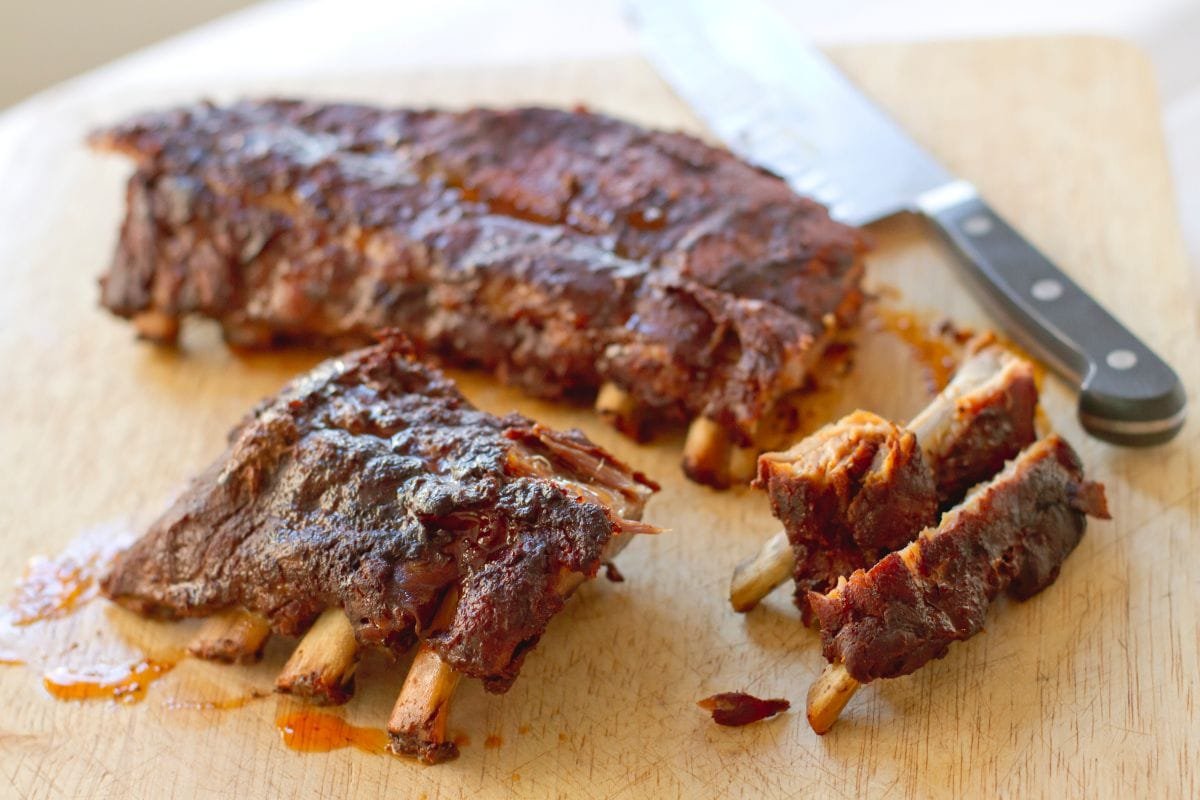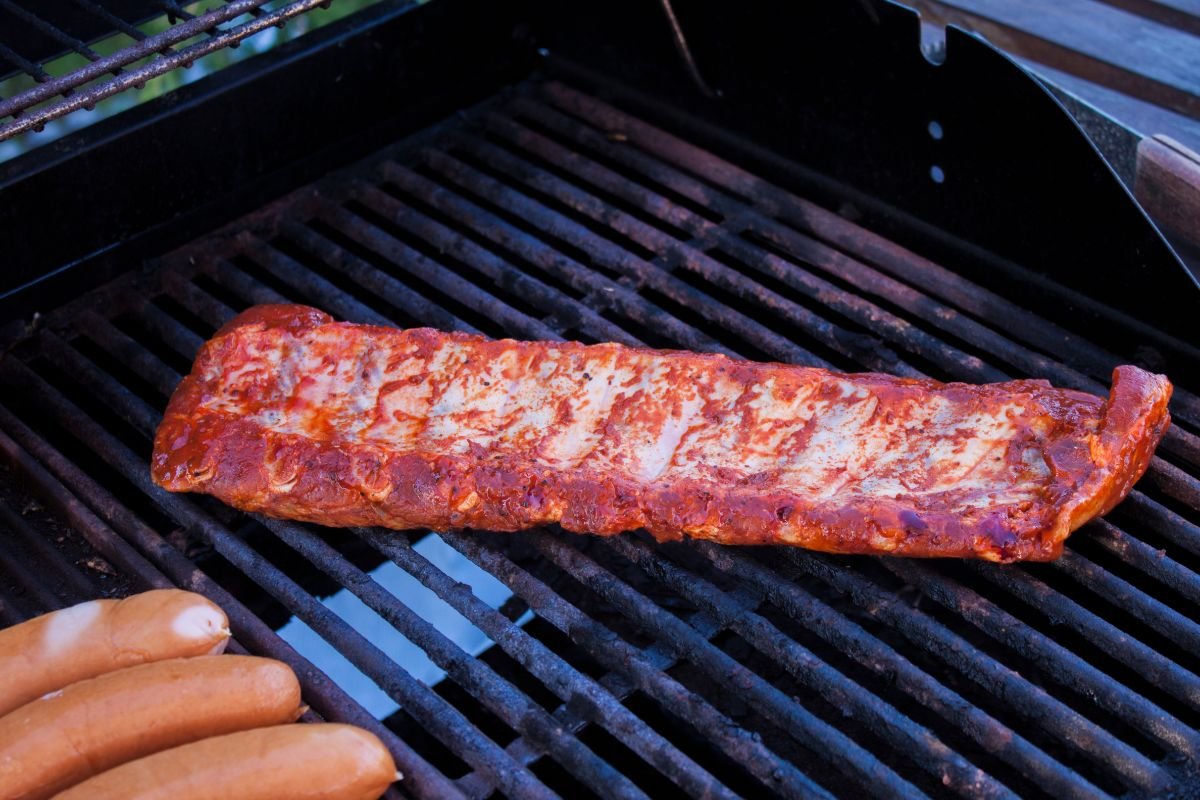We all enjoy ribs, whether they are cooked in the oven, roasted on the grill, or smoked gently in your very own smoker.
However, there are many types of ribs out there and each one cooks very differently from the other.

When you are picking up your ribs directly from the butcher, it might be quite difficult to tell how exactly to prepare them.
This is especially true when it comes to preparing pork loin ribs and baby back ribs. What exactly is the difference between the two?
How can you separate pork loin ribs and baby back ribs? What are the various differences when it comes to prep, cooking and eventually serving them?
Well, if you are looking for the answers to all of these questions and more, we would recommend that you keep reading.
What Are Pork Loins?
If you take a look at a pig’s skeleton and find the point where the ribcage connects to the spine, then this is the place from where the pork loin back rib originates.
Once the loin is removed, then this small portion of the spine is taken out. Contrary to popular belief, these pork loin ribs, also known as ‘baby back ribs’ are not taken from baby pigs.
They are called this because this piece of rib is unusually small, only around 3 to 6 inches in length.
The only difference between pork loin back ribs and baby back ribs will be the size of the ribs themselves, which is often only due to the size of the pig.
As with all lean meat, you’ll need to take some precautions when you are grilling this one, as it will burn very quickly.
How Many Racks Of Ribs Should You Buy?
This will all depend on how many racks of ribs you’ll want to eat or how many guests you’ll be serving at your barbeque.
If you are measuring your ribs by person, you’ll probably need to allow around 5-6 racks of ribs per person.
When it comes to ribs, pigs only have about 15 or 16 each. However, not all of these ribs will be able to be used for meat.
Some of the ribs will be separated from the shoulder when the pig is separated for meat.
This is why when you go to the butchers, you’ll be getting around 8 racks of ribs, although you can get one or two ribs on either side of this, again, depending on the size of the pig itself.
A ‘cheater rack’ is when there are less than 10 ribs on a rack.
A rack of baby back ribs will have around 10-13 ribs and will weigh around 1 and 2 pounds. This means a rack of ribs could potentially feed around 2 people.
This might not be true if you have a smaller set of ribs, even if they are the same length.
You might have heard of a cut of meat that is called a ‘shiner’, which is when the meat is tender and lean, but there is actually so little meat on the bone that all you might see is bone.
These kinds of meat are a lot more prone to overcooking, so you should keep an eye on it when you are grilling it to make sure it doesn’t turn out dry.

What Is the Difference Between Pork Loin Ribs And Spare Ribs?
One of the best methods of telling apart pork loin ribs from spare ribs is by looking at how they’re shaped.
Spare ribs often come in a flat and rectangular shape, whereas the pork loin rib, coming straight from the middle spine, will over appear rounded.
The curve in the spine will often make it much more difficult to sear the meat properly. This is why spare ribs are used for a lot more recipes, as they are a lot more pliable.
Baby back ribs are often considered to be a very lean type of meat, whereas pork loin ribs are very fatty and will take a lot longer to cook because of this.
However, with a pork loin, you might get some loin meat that is attached to the top.
Pork loins are also triangular in shape, although this will be due to the shape of the ribcage in general. This means it will be a lot shorter at one end.
Most people who consume meat will more than likely prefer to consume baby back ribs than they would spare ribs.
This is why it will often be more expensive to buy baby back ribs, due to the increased demand.
This means that if you are going to be feeding a larger group of people, then you might end up shelling out a lot more cash. You might prefer to go with spare ribs due to the lower price and the versatility.
If you are seeing a rack of ribs in your butchers that are marked with the label ‘St. Louis ribs’, then you’ll need to know that these are a rack of spare ribs that have had the sternum, the tips and the cartilage removed.
This type of rib is generally a lot neater, although it does have the same texture as spare ribs.
What Makes Pork Loin Ribs Different from Baby Back Ribs?
What makes pork loin ribs different from baby back ribs? The key difference between prime rib and ribeye lies in the type of meat. While they are both cuts from the beef, prime rib comes from the primal rib section, closer to the shoulder, and is known for its tenderness and rich flavor. Ribeye, on the other hand, is taken from the rib section, closer to the loin, offering a marbled texture and intense taste.
The Best Method Of Cooking Pork Loin Ribs
Ribs are one of the most naturally delicious meats that you can get for your money.
They come with some naturally very delicious properties, however, they also respond very well to spices, rubs, mustard, paprika and cayenne peppers.
You can even rub brown sugar onto a pork loin rib. This will give you meat that extra sugary texture which will caramelize and result in a very interesting final texture and taste.
You should be aware that sugar burns at a very high temperature, so keep an eye on your pork loins when you are cooking with sugar on top.
When you are cooking this type of rib, make sure that you cook it at a much lower temperature, as this will cause it to burn on the outside rather than cook all the way through to the middle.
If you are cooking lower and for longer, then this will allow the heat to sear right through to the middle. Once you have done this, then the fat will have rendered and the tissues will have broken down.
If you are adding sauce to your pork loin, then you’ll need to be careful not to add it too early in the cooking process.
This is because the sauce can burn when exposed to heat. You should leave this part of the process until a few minutes toward the end of cooking.
If you are adding barbeque sauce, then you’ll need to remember that it does contain a lot of sugar.
This means that it will be prone to burning a lot quicker. If barbeque sauce burns, then it gives your meat a very bitter flavor.
What To Cook Instead Of Pork Loin Ribs
If you can’t find any pork loin ribs in your butchers, then what else can you cook on your smoker or barbeque? Can you easily swap out this kind of meat for another kind such as spare ribs or St. Louis ribs?
Yes, you can, although you might need to adjust a few things.
If you are working from a recipe that specifies baby back ribs but you only have spare ribs, then you will need to cut down on the number of racks by around one-third.
This is because spare ribs are much fattier and will need a lot longer to cook.
You might only need 1 or 2 hours to cook baby back ribs, whereas spare ribs might need twice as long, due to all the fat on them.
However, you won’t need to worry as much about overcooking your spare ribs for the very same reason.
You’ll need to account for the difference in size and weight when you are seasoning too. You should also try and add a little more salt to the rubbing process.
If you are adding other seasonings, then you will need to adjust them for taste.
Conclusion
We hope that our guide to the difference between pork loin rib and baby back rib has helped you when deciding which one you’ll be using for your barbeque or grill.
You should always make sure that if you are substituting pork loin for spare ribs, you’ll have to increase the cooking time.
